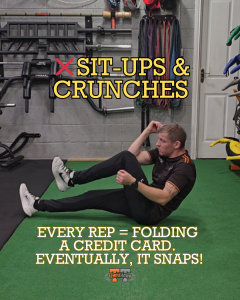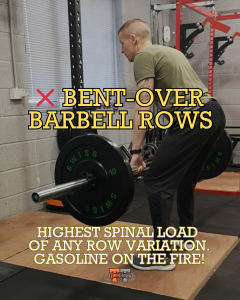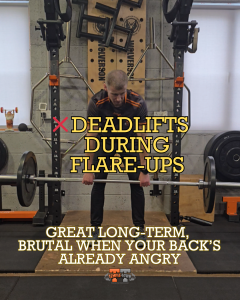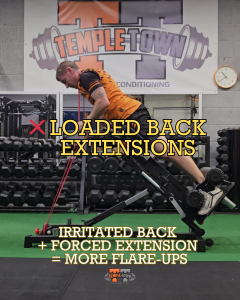The 5 Gym Moves That Wreck Your Back (And Smarter Swaps You Need to Know)
If you train hard but your back still feels like a ticking time bomb, the problem may not be your age, your genetics, or even your posture.
The real culprit? The exercises you’re choosing in the gym.
After coaching hundreds of men and women in their 30s, 40s, and 50s, I’ve seen the same cycle over and over: people think their spine is “broken” when in reality it’s just being pushed past its tolerance by the wrong movements.
This article reveals the five most common gym exercises that secretly wreck your back, plus the safer swaps that allow you to keep training hard without flare-ups.
Why Exercise Choice Matters More Than You Think
Most people believe pain equals damage. But the science doesn’t back that up.
Disc bulges show up in pain-free 25-year-olds on MRI scans.
Many people with “perfect” scans can barely tie their shoes due to pain.
Guidelines now recommend staying active and using exercise as one of the best treatments for non-specific low back pain.
What this means: it’s not about avoiding training, it’s about matching your exercise choices to your current tolerance.
The 5 Exercises That Sabotage Your Back (And What to Do Instead)
1. Sit-Ups and High-Rep Crunches
Why they hurt:
Sit-ups repeatedly fold your spine into flexion, compressing the discs in a way that often irritates people with a history of back pain. Research from Dr. Stuart McGill’s lab shows we only get a limited number of flexion “cycles” before tissue starts to break down.

Smarter swaps:
✅ Modified curl-ups
✅ Side plank progressions
✅ Bird dog variations
These build core endurance and control with far less spinal stress.
2. Heavy Bent-Over Barbell Rows
Why they hurt:
Lab data shows bent-over rows produce some of the highest spinal loads of any rowing variation. Great for upper back strength, but brutal on your lumbar spine, especially if you’re already sore.

Smarter swaps:
✅ Chest-supported rows
✅ Single-arm cable rows
✅ Inverted rows
These deliver the same upper back development without your lower back working overtime.
3. Conventional Deadlifts from the Floor (During Flare-Ups)
Why they hurt:
Deadlifts aren’t bad – in fact, they can be brilliant when timed right. But when you’re already irritated, the bar path and torso angle of a floor pull spike shear forces on your lower back.

Smarter swaps:
✅ Trap bar deadlift (especially with high handles)
✅ Rack pulls from the knees
✅ Romanian deadlifts with controlled tempo
These build posterior chain strength without the same level of lumbar stress.
4. Loaded Back Extensions (When You’re Already Irritated)
Why they hurt:
Back extensions increase lumbar extension and can narrow the nerve pathways, making some symptoms worse.

Smarter swaps:
✅ Glute bridge progressions
✅ Hip thrusts
✅ Isometric holds like the superman
These hammer your glutes and hamstrings without forcing your spine into painful end ranges.
5. High-Rep Kettlebell Swings with Sloppy Form
Why they hurt:
Swings are fantastic… when done perfectly. McGill’s lab measured both high compressive and shear loads during swings. If your hinge is shallow or you chase fatigue, your back tolerance can quickly be exceeded.

Smarter swaps:
✅ Hip-hinge patterning drills
✅ Cable pull-throughs
✅ Swing clusters (strict technique, low fatigue)
Master the hinge first, then earn your swings back.
4 Rules for Training with Back Pain
If you want lasting confidence in the gym, apply these four principles:
1. Find your sweet spot spine position. Not ramrod straight, not slouched – mid-range where you can breathe.
2. Brace like an invisible weight belt. Gentle 360-degree expansion. Don’t hold your breath.
3. Change one thing at a time. Progress load, range, or speed. Never all three at once.
4. Quality first, ego last. Perfect reps beat chasing fatigue every single time.
Example Back-Smart Pull Day
Here’s how these swaps and rules come together:
Warm-up: brisk walk or bike, hip hinge rocks and T-spine rotations
✅ Core prep: bird dog, side plank and modified curl-up
✅ Main lifts: trap bar deadlift and chest-supported row
✅ Accessory work: cable pull-through and Pallof press
✅ Finisher: farmer carry with tall posture
This isn’t random rehab – it’s a progressive strength session that respects your tolerance while building capacity.
Quick Wins You Can Use This Week
✅ Swap sit-ups for side planks.
✅ Swap bent-over rows for chest-supported rows.
✅ Swap floor deadlifts for trap bar or rack pulls.
✅ Dial swings back to hinge drills if symptoms flare.
✅ This week’s podcast for the swaps you NEED to train hard without flare-ups.
🎧 Listen now on Spotify & Apple Podcasts
Episode 9: The 5 Gym Moves That Wreck Your Back (And What To Do Instead)
You’re Not Broken…
Here’s the hard truth: band-aid swaps can help short-term, but lasting results come from following a complete system.
That’s why I created BackFix Coaching – to give people in their 30s, 40s, and 50s a proven path from flare-ups and fear to strength and confidence.
Inside the program, we:
✅ Match training to your tolerance
✅ Progress you week by week
✅ Teach you to move powerfully without flare-ups
✅ Build the strength and confidence you thought you’d lost
Ready to Train Smarter (Not Broken)?
You can keep guessing and hoping it works out, or you can shortcut the trial-and-error with a system already helping men and women just like you.
👉🏻 To apply for BackFix Coaching:
Email me at info@templetownsc.com with “READY” in the subject line
Or DM me “STRONG” on Instagram @TempletownStrengthConditioning
Let’s build a smarter plan that finally gives you the strength, confidence, and freedom you deserve.

